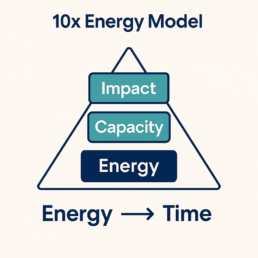Beyond time: The energy advantage for 10x leadership
For decades, productivity has been anchored in time. But as complexity rises, that model shows its
limits.
It’s not that time doesn’t matter — it does. But energy is the multiplier.
Enter the 10x Principle: a high-performance mindset that recognises energy — not time — as the
currency that drives decision-making, wellbeing, and sustainable leadership. This paper offers a
science-backed, compassionate reframe of performance for female leaders, grounded in insights from
Firstbeat Life™, Tony Schwartz, Jim Loehr, Deb Dana, Dr. Saundra Dalton-Smith, and others at the
intersection of physiology, psychology, and leadership.
Time management is good, energy management is transformational
“Time is finite. Energy is renewable — if managed wisely.” — Tony Schwartz
Time management has helped many leaders become more efficient. But at the
highest levels of responsibility, efficiency is no longer enough. What leaders
need is capacity — the ability to show up fully with clarity, resilience, presence,
and focus.
While time is measured in hours, energy is measured in:
- Attention span
- Recovery patterns
- Emotional bandwidth
- Physiological readiness (HRV, sleep, stress)
When energy is low, even ample time leads to poor-quality work and strained
relationships. When energy is high, less time can yield better outcomes. That’s
the 10x effect.
Biofeedback & energy depletion in leadership
Using Firstbeat Life’s™ Heart Rate Variability (HRV) data, we uncover an often-
hidden story:
- Evenings show no recovery, especially in women leaders
- Micro-stress spikes occur before or after meetings
- Weekends don’t offset chronic depletion
These are not signs of failure, but of physiology responding to unrelenting
demands without space for recovery.
The glass cliff & invisible demands on women
Research shows women are more likely to be promoted into leadership roles
during times of crisis — a phenomenon known as the glass cliff. These roles
often bring:
- Higher risk and scrutiny
- Lower support
- Increased emotional and relational demands
Women also carry more “invisible work”—being the emotional stabilisers of both
teams and homes. These roles cost energy, even when they’re not formally
recognised.
These high-stakes roles require not just strategic acumen but extraordinary
emotional and energetic reserves — often without the scaffolding needed to
replenish them.
From emotional overload to automatic wisdom
The nervous system, as explored by Stephen Porges and Deb Dana, helps us
understand that:
- A regulated nervous system promotes clarity, creativity, and calm
- Chronic over-activation leads to burnout, disconnection, and reactivity
Leadership requires nervous system literacy — the ability to recognise,
regulate, and lead from a place of embodied awareness. This isn’t a luxury. It’s a
modern leadership competency.
Three underrated causes of burnout in high-achieving women
Burnout often stems not from the obvious pressures, but from overlooked drains
such as:
- Misaligned Values — Doing work that lacks personal meaning
- Invisible Cognitive Load — Planning, remembering, managing others
- Lack of Micro-Recovery — No short breaks, transitions, or repair time
These are energy leaks. Over time, they become performance issues.
10x leadership practices for sustainable impact
To lead at 10x, you don’t need more hours — you need to build energy capacity:
- Schedule energy-restoring rituals within your workday
- Prioritise recovery with the same discipline as performance
- Align leadership style with your nervous system’s natural rhythms
- Create psychologically safe, energy-efficient cultures
- Use data (like HRV) to lead with awareness and impact
“Great leaders aren’t the ones who do the most. They’re the ones who bring the
most of themselves to what matters.” – Tony Schwartz, co-author of The Power of
Full Engagement

A simple model to guide energy-centric leadership:
FOUNDATION: Nervous System Regulation
CORE: Purpose & Values Alignment
SYSTEM: Energy Awareness (HRV, rest, emotions)
PRACTICE: Micro-Recovery, Emotional Literacy, Restorative Leadership Habits
IMPACT: Clarity, Capacity, Compassion, Creativity
Closing thought
As the workplace evolves, so too must our understanding of leadership. The 10x
principle isn’t about doing more. It’s about becoming more energy-intelligent —
leading with both strategy and humanity.
In this new era, energy is the leadership edge.
